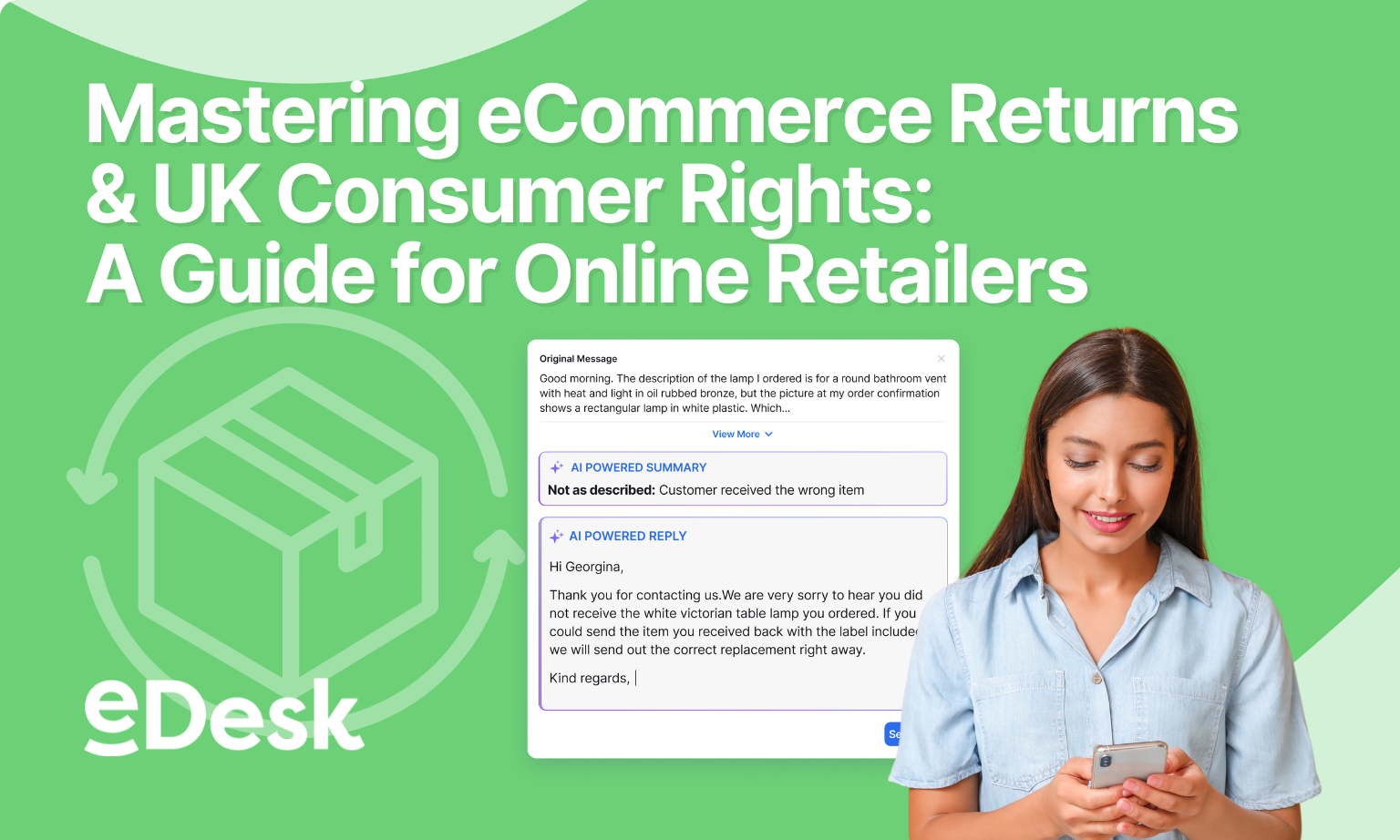In the rapidly evolving world of UK eCommerce, understanding consumer rights and creating effective returns policies isn’t just about legal compliance—it’s about building trust, reducing costs, and fostering long-term customer relationships. With the average return rate for eCommerce reaching 16.9% in 2024 and UK eCommerce returns reaching a staggering £4.2 billion in 2023, mastering this landscape has never been more crucial for online retailers.
The Current State of UK eCommerce Returns
The numbers paint a striking picture of the returns landscape in the UK. 49% of UK online shoppers have returned goods in the past year, with this figure rising to 60% for younger demographics aged 16-34. This trend reflects a fundamental shift in consumer behaviour, where returns are no longer viewed as problematic but as an integral part of the online shopping experience.
Clothing leads the way as the most returned online purchase category, with 28% of UK respondents returning clothing items in 2024, highlighting the particular challenges faced by fashion retailers. Meanwhile, the clothing and apparel category processes the majority of returns, leading with a 26% return rate compared to hobby supplies and garden products at just 6%.
Understanding the Consumer Rights Act 2015
The Consumer Rights Act 2015 forms the backbone of UK consumer protection for eCommerce transactions. This comprehensive legislation establishes clear standards that all online retailers must meet:
Key Provisions for Online Sales
Quality Standards: The Act ensures that products meet certain standards of quality, are fit for purpose, and match their description. For online retailers, this means your product descriptions, images, and specifications must accurately represent what customers will receive.
Retailer Responsibility: The Consumer Rights Act 2015 states that the retailer is responsible for the condition of goods until they are received by the customer or someone nominated to receive them on their behalf. This places liability for courier services squarely on the retailer’s shoulders.
Repair and Replacement Rights: If a customer returns an item within 6 months, you must repair or replace it unless you can prove it was not faulty when they bought it. This provision protects consumers whilst giving retailers clear guidelines for handling defective products.
Faulty Goods and Legal Remedies
When goods are genuinely faulty, consumers have robust protection under the Consumer Rights Act 2015. Customers can ‘accept’ an item, but if they later discover a fault, you may have to repair or replace it, and the customer can still reject the item after it’s been repaired or replaced.
Distance Selling Regulations UK: The 14-Day Rule
Distance selling regulations provide additional protection for UK consumers purchasing online, reflecting the fact that they cannot physically inspect items before purchase.
Cooling-Off Period Rights
Online, mail and telephone order customers have the right to cancel their order for a limited time even if the goods are not faulty. You must offer a refund to customers if they’ve told you within 14 days of receiving their goods that they want to cancel.
The mechanics of this process are clearly defined:
- Customers have 14 days from receipt to notify you of cancellation
- They have another 14 days to return the goods once they’ve told you
- You must refund the customer within 14 days of receiving the goods back
- They do not have to provide a reason
Extended Rights for Non-Disclosure
If you do not tell the customer about their right to cancel, they can cancel at any time in the next 12 months. If you tell them about the right to cancel during these 12 months, they have 14 days to cancel from when you told them. This emphasises the critical importance of transparent communication about cancellation rights.
Creating Compliant and Customer-Friendly Returns Policies
Developing effective refund policies requires balancing legal compliance with business sustainability. According to a survey by the NRF, 60% of customers said that a good returns policy is important when making an online purchase, making this a competitive differentiator.
Essential Policy Elements
Clear Communication: Your returns policy should be easily accessible and written in plain English. The Consumer Contracts Regulations 2013 require businesses to provide consumers with clear and comprehensive pre-contract information, including details about cancellation rights.
Transparency About Costs: While you’re not legally required to cover return shipping costs for non-faulty items, two-thirds of retailers introduced return fees last year, mainly because operations and shipping got more expensive. If you charge for returns, make this clear upfront.
Processing Timeframes: Set realistic expectations for refund processing times while staying within the legal 14-day requirement for issuing refunds after receiving returned goods.
Best Practices for Policy Development
Consider implementing these proven returns management strategies to enhance your policy effectiveness:
- Detailed Product Information: Invest in comprehensive product descriptions, size guides, and high-quality images to reduce returns caused by unmet expectations
- Flexible Return Windows: While 14 days is the legal minimum, offering longer periods can improve customer satisfaction
- Multiple Return Options: Consumers show a clear preference for returning items in physical stores, with 62% expressing their inclination for this alternative
For guidance on writing an effective eCommerce returns policy, focus on clarity, fairness, and alignment with your business model.
Managing Return Costs and Fraud Prevention
The financial impact of returns extends far beyond lost sales. The cost to process a return can be anywhere from 20%–65% of the item’s original value, making efficient management essential for profitability.
Cost Reduction Strategies
Quality Control: Address the root causes of returns by improving product quality, descriptions, and fulfillment accuracy. Understanding how sellers can win the war on online returns starts with prevention.
Technology Solutions: Implement systems to track return reasons, identify patterns, and flag potential serial returners who may be exploiting your policy.
Alternative Resolutions: Consider offering store credit, exchanges, or partial refunds to keep revenue within your business rather than processing full refunds.
Alternative Dispute Resolution (ADR) in the UK
When returns escalate into disputes, Alternative Dispute Resolution provides a cost-effective alternative to court proceedings for both retailers and consumers.
Understanding ADR Requirements
The regulations do not make participation in ADR schemes mandatory for traders. However, they do require almost all businesses which sell directly to consumers to point the consumer to a certified ADR scheme when they cannot resolve a dispute in-house and declare whether or not they intend to use that scheme.
Types of ADR Available
The two most common types of ADR are mediation and arbitration. Mediation is where an independent third party helps you and the company you’re in a dispute with to reach a mutually acceptable outcome. Arbitration is where an independent third party considers the facts and takes a decision that’s legally binding.
ADR Benefits for eCommerce Businesses
ADR is usually a cheaper and quicker route for resolving a dispute than the alternative of beginning legal proceedings in court. For online retailers, this means:
- Reduced legal costs and time investment
- Maintained customer relationships through professional mediation
- Industry-specific expertise from specialised ADR providers
- Sometimes consumers can access these for free, so they may wish to use them for a consumer dispute with you
Legal Obligations for Online Businesses
As an eCommerce business, you must let your customers know information about ADR. You must let them know a certified ADR provider and whether or not you plan to use them. This information can be included in your terms and conditions or customer service pages.
Building Customer Satisfaction Through Returns Excellence
Excellent returns management goes beyond legal compliance to create competitive advantage. 45% of UK consumers are concerned about the environmental impact of over ordering and returning items, with 71% willing to consider paying extra for a more sustainable return option.
Creating Positive Return Experiences
Focus on mastering a stress-free returns process by:
- Streamlining your returns portal for easy initiation
- Providing clear instructions and prepaid return labels where possible
- Offering status updates throughout the return process
- Training customer service teams to handle returns professionally
Sustainable Practices
Consider implementing environmentally conscious return options such as:
- Consolidation of multiple returns to reduce packaging
- Partnerships with local collection points
- Refurbishment and resale programmes for returned items
- Clear communication about your sustainability efforts
Future-Proofing Your Returns Strategy
The returns landscape continues to evolve, with eCommerce return rates expected to grow by $1.4 trillion by 2025. Staying ahead requires continuous adaptation of your policies and processes.
Emerging Trends to Monitor
- Increased use of AI for fraud detection and return predictions
- Growth in omnichannel return options combining online and offline channels
- Rising consumer expectations for instant refunds and seamless processes
- Greater emphasis on sustainability and circular economy principles
Technology Integration
Invest in systems that provide real-time visibility into your returns process, enabling proactive customer communication and efficient inventory management. Integration with customer service platforms can help identify returning customers and provide personalised support.
Conclusion
Mastering UK consumer rights and eCommerce returns requires a comprehensive approach that balances legal compliance, customer satisfaction, and business sustainability. The Consumer Rights Act 2015 and distance selling regulations provide a clear framework for protecting consumers whilst giving retailers the guidelines needed to operate effectively.
Success in this area comes from viewing returns not as a necessary evil, but as an opportunity to differentiate your brand through excellent service. By implementing clear policies, leveraging technology solutions, and understanding your ADR obligations, you can transform returns from a cost centre into a competitive advantage.
The retailers who thrive in today’s market are those who embrace returns as part of the customer journey, using them to build trust, gather valuable feedback, and demonstrate their commitment to customer satisfaction. With the right strategy and tools in place, effective returns management becomes not just about compliance, but about creating lasting customer relationships that drive long-term business growth.
Transform your returns management from a costly headache into a competitive advantage with the right tools and strategies. eDesk’s comprehensive customer service platform helps online retailers streamline their returns process while ensuring full compliance with UK consumer rights legislation.
Start your free trial with eDesk today and discover how automated returns management can reduce costs, improve customer satisfaction, and protect your business from disputes.




